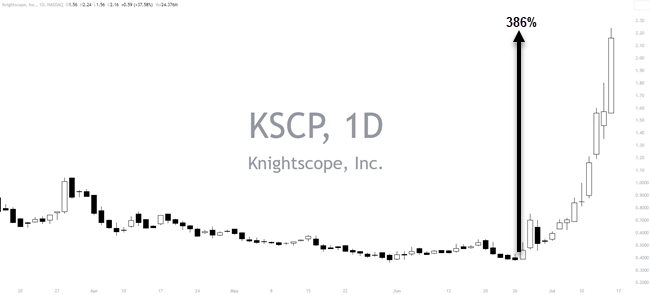- September 14, 2023
- Posted by: Shane Daly
- Categories: Stock Trading, Trading Article

Penny stock trading, a speculative investment strategy involving the buying and selling of shares in small, low-priced companies, presents both risks and rewards for traders.
These stocks, typically valued under $5 in the US offer the potential for substantial returns if the right stock is identified. However, caution must be used as penny stocks are known for their lack of transparency and liquidity, making them vulnerable to fraudulent schemes like pump and dump.
 Pink sheet stocks, traded on the OTCBB or Pink Sheets, often have limited available company information and are at a higher risk of fraud. Nevertheless, trading penny stocks listed on formal exchanges like NASDAQ or NYSE can reduce the likelihood of scams.
Pink sheet stocks, traded on the OTCBB or Pink Sheets, often have limited available company information and are at a higher risk of fraud. Nevertheless, trading penny stocks listed on formal exchanges like NASDAQ or NYSE can reduce the likelihood of scams.
To navigate this volatile market, extensive research and the use of stock screeners are essential. Traders must also understand the significance of technical setups and remain mindful of the high level of risk involved.
By analyzing both the risks and rewards, traders can make better decisions and potentially benefit from penny stock trading.
Key Takeaways
- Penny stocks are associated with small, usually new businesses that may not offer significant growth
- Penny stocks are riskier than traditional stocks and lack transparency and liquidity
- Penny stocks can be highly volatile and experience significant price fluctuations
- Extensive research is necessary before deciding to day trade penny stocks
The Risks Of Penny Stock Trading
Penny stock trading carries inherent risks due to the lack of transparency, liquidity, and potential for scams, making it imperative for investors to understand the potential downsides before engaging in this volatile market.
Due diligence plays a crucial role in mitigating these risks. Traders must thoroughly research and analyze the financial health, management team, and overall business prospects of penny stock companies.
Scams, such as pump and dump schemes, are prevalent in the penny stock market. These activities involve artificially inflating the price of a stock through false or misleading information, only to sell at a profit once the price has risen. Investors must be cautious and skeptical of any sudden and unrealistic price movements or exaggerated claims.
By conducting thorough due diligence and remaining vigilant against scams, investors can better navigate the risks associated with penny stock trading.
The Rewards
One potential benefit of trading low-priced equities is the opportunity for substantial returns on investment if the appropriate stock is identified.
 Despite the risks associated with penny stock trading, there have been success stories of individuals who have made significant gains.
Despite the risks associated with penny stock trading, there have been success stories of individuals who have made significant gains.
- Explosive Price Movement: Penny stocks have the potential to experience rapid and dramatic price increases, allowing traders to capitalize on these price swings and generate substantial profits.
- Undervalued Companies: Some penny stocks represent undervalued companies with growth potential. If investors can identify these hidden gems and invest early, they may benefit from the future success of these companies.
- Low Entry Cost: One advantage of penny stocks is their low entry cost. Investors can purchase large quantities of shares at a relatively low price, allowing for the possibility of significant returns on a small initial investment.
These potential gains come with a high level of risk, as penny stocks are highly volatile and can result in the loss of capital.
Trading Tips
To increase the chances of success in trading with low-priced equities, pay attention to technical analysis and chart patterns.
Technical analysis involves looking at historical price and volume data to predict future stock movements. Traders can use various trading indicators and tools to identify trends, support and resistance levels, and entry and exit points. It is important to analyze the price and volume patterns of penny stocks to make informed trading decisions.
 Finding the right broker is vital when trading penny stocks. Traders should choose a reputable broker that offers competitive commission fees, reliable trading platforms, and access to the necessary research tools and resources. A good broker can provide valuable support and guidance, especially for novice traders in the penny stock market.
Finding the right broker is vital when trading penny stocks. Traders should choose a reputable broker that offers competitive commission fees, reliable trading platforms, and access to the necessary research tools and resources. A good broker can provide valuable support and guidance, especially for novice traders in the penny stock market.
Frequently Asked Questions
What are some common strategies for identifying potential penny stock opportunities?
Common strategies for identifying potential penny stock investments involve a combination of technical analysis and fundamental analysis.
Technical analysis involves studying historical price movements and patterns to identify potential buying opportunities. Traders may use indicators and chart patterns to spot trends and make informed decisions.
Fundamental analysis involves evaluating a company’s financial health, management team, and market position. By analyzing both the technical and fundamental aspects of a penny stock, investors can make more informed decisions about potential investments.
How can I protect myself from penny stock scams
To protect yourself from penny stock scams, traders must exercise caution. Diligent research is crucial, allowing potential investors to scrutinize the background and credibility of the company.
Additionally, trading penny stocks exclusively on reputable exchanges like NASDAQ or NYSE can minimize the risk of falling victim to fraudulent activities.
Are there any specific regulations or requirements for trading penny stocks?
Penny stock trading is subject to certain regulatory requirements.
In the United States, the Securities and Exchange Commission (SEC) imposes regulations to protect investors.
For instance, the SEC requires companies to provide accurate and timely information to the public. Brokers must comply with specific rules when facilitating penny stock transactions, such as providing investors with a risk disclosure document.
These regulations aim to enhance transparency and protect investors from fraudulent schemes and scams associated with penny stocks.
What are some key indicators or warning signs to look out for when evaluating penny stocks?
Key indicators to evaluate penny stocks include financial reports, trading volume, and price fluctuations. Common warning signs in penny stock trading include lack of transparency, limited company information, and susceptibility to scams.
It is important to be cautious of penny stocks listed on pink sheets, as they have a higher risk of fraud. Trading penny stocks listed on formal exchanges like NASDAQ or NYSE can help mitigate these risks.
Extensive research is necessary to make informed decisions and avoid potential losses.
Can penny stock trading be a viable long-term investment strategy, or is it more suitable for short-term trading?
Penny stock trading as a long-term investment strategy has both pros and cons.
On the positive side, penny stocks have the potential for significant returns if the right stock is found.
However, the high volatility of penny stocks can make them risky and unpredictable. Market volatility plays a crucial role in penny stock trading, as it can lead to substantial price fluctuations.
It is important to carefully evaluate the risks and benefits before considering penny stock trading as a long-term investment strategy.
Conclusion
Penny stock trading can offer significant returns, but it also comes with a high level of risk. The lack of transparency and liquidity in these stocks makes them susceptible to scams and fraud.
However, by trading penny stocks listed on formal exchanges, traders can reduce the risk of scams. Extensive research and the use of stock screeners are crucial for effective trading.
It is important to remember that penny stocks are highly volatile and can result in the loss of capital. As the saying goes, ‘Do your due diligence before diving into penny stock trading.’
